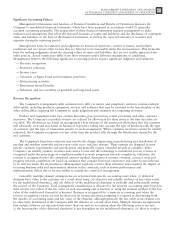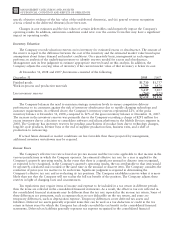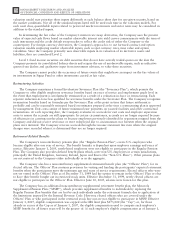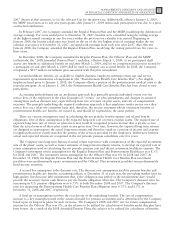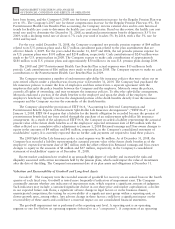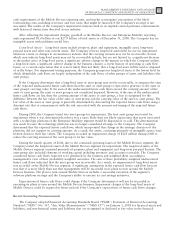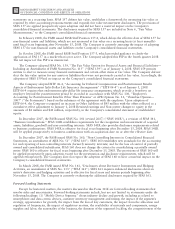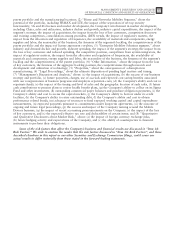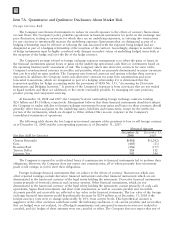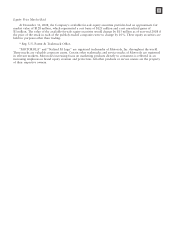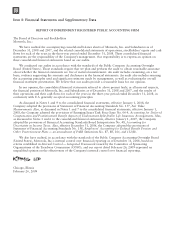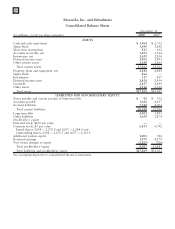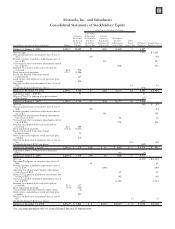Motorola 2008 Annual Report Download - page 84
Download and view the complete annual report
Please find page 84 of the 2008 Motorola annual report below. You can navigate through the pages in the report by either clicking on the pages listed below, or by using the keyword search tool below to find specific information within the annual report.
statements on a recurring basis. SFAS 157 defines fair value, establishes a framework for measuring fair value as
required by other accounting pronouncements and expands fair value measurement disclosures. The provisions of
SFAS 157 are applied prospectively upon adoption and did not have a material impact on the Company’s
consolidated financial statements. The disclosures required by SFAS 157 are included in Note 6, “Fair Value
Measurements,” to the Company’s consolidated financial statements.
In February 2008, the FASB issued FASB Staff Position 157-2, which delays the effective date of SFAS 157 for
non-financial assets and liabilities, which are not measured at fair value on a recurring basis (at least annually)
until fiscal years beginning after November 15, 2008. The Company is currently assessing the impact of adopting
SFAS 157 for non-financial assets and liabilities on the Company’s consolidated financial statements.
In October 2008, the FASB issued FASB Staff Position 157-3, which provided guidance to clarify the
application of FAS 157 in a market that is not active. The Company adopted this FSP in the fourth quarter 2008.
The net impact of this FSP was immaterial.
The Company adopted SFAS No. 159, “The Fair Value Option for Financial Assets and Financial Liabilities—
Including an Amendment of FASB Statement No. 115” (“SFAS 159”) as of January 1, 2008. SFAS 159 permits
entities to elect to measure many financial instruments and certain other items at fair value. The Company did not
elect the fair value option for any assets or liabilities that were not previously carried at fair value. Accordingly, the
adoption of SFAS 159 had no impact on the Company’s consolidated financial statements.
The Company adopted EITF 06-4, “Accounting for Deferred Compensation and Postretirement Benefit
Aspects of Endorsement Split-Dollar Life Insurance Arrangements” (“EITF 06-4”) as of January 1, 2008.
EITF 06-4 requires that endorsement split-dollar life insurance arrangements, which provide a benefit to an
employee beyond the postretirement period be recorded in accordance with SFAS No. 106, “Employer’s
Accounting for Postretirement Benefits Other Than Pensions” or APB Opinion No. 12, “Omnibus Opinion—
1967” (“the Statements”) based on the substance of the agreement with the employee. Upon adoption of
EITF 06-4, the Company recognized an increase in Other liabilities of $45 million with the offset reflected as a
cumulative-effect adjustment to January 1, 2008 Retained earnings and Non-owner changes to equity in the
amounts of $4 million and $41 million, respectively, in the Company’s consolidated statement of stockholders’
equity.
In December 2007, the FASB issued SFAS No. 141 (revised 2007) (“SFAS 141R”), a revision of SFAS 141,
“Business Combinations.” SFAS 141R establishes requirements for the recognition and measurement of acquired
assets, liabilities, goodwill and non-controlling interests. SFAS 141R also provides disclosure requirements related
to business combinations. SFAS 141R is effective for fiscal years beginning after December 15, 2008. SFAS 141R
will be applied prospectively to business combinations with an acquisition date on or after the effective date.
In December 2007, the FASB issued SFAS No. 160, “Non-Controlling Interests in Consolidated Financial
Statements, an amendment of ARB No. 51” (“SFAS 160”). SFAS 160 establishes new standards for the accounting
for and reporting of non-controlling interests (formerly minority interests) and for the loss of control of partially
owned and consolidated subsidiaries. SFAS 160 does not change the criteria for consolidating a partially owned
entity. SFAS 160 is effective for fiscal years beginning after December 15, 2008. The provisions of SFAS 160 will
be applied prospectively upon adoption except for the presentation and disclosure requirements, which will be
applied retrospectively. The Company does not expect the adoption of SFAS 160 to have a material impact on the
Company’s consolidated financial statements.
In March 2008, the FASB issued SFAS No. 161, “Disclosures about Derivative Instruments and Hedging
Activities, an amendment of SFAS No. 133” (“SFAS 161”). SFAS 161 requires enhanced disclosures about an
entity’s derivative and hedging activities and is effective for fiscal years and interim periods beginning after
November 15, 2008. The Company is currently evaluating the additional disclosures required by SFAS 161.
Forward-Looking Statements
Except for historical matters, the matters discussed in this Form 10-K are forward-looking statements that
involve risks and uncertainties. Forward-looking statements include, but are not limited to, statements under the
following headings: (1) “Mobile Device Segment,” about industry decline and growth, including as related to
smartphones and data-centric devices, customer inventory management and timing, the impact of the segment’s
strategy, opportunities for growth, the impact from the loss of key customers, the impact from the allocation and
regulation of frequencies, the impact of regulatory matters, the availability of materials and components, energy
supplies and labor, the seasonality of the business, the firmness of the segment’s backlog, the competitiveness of the
76 MANAGEMENT’S DISCUSSION AND ANALYSIS
OF FINANCIAL CONDITION AND RESULTS OF OPERATIONS



